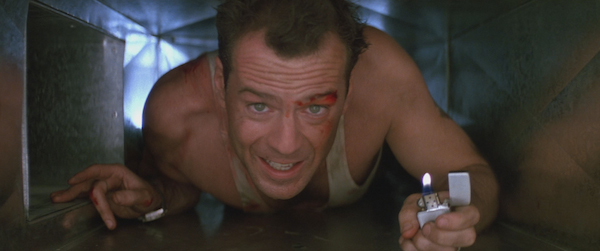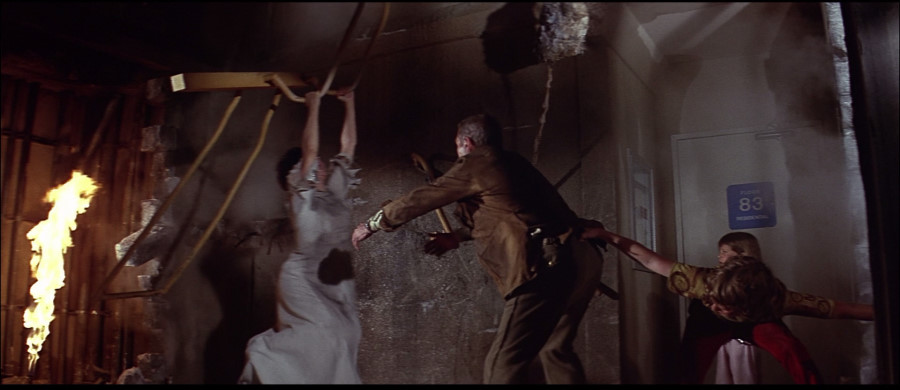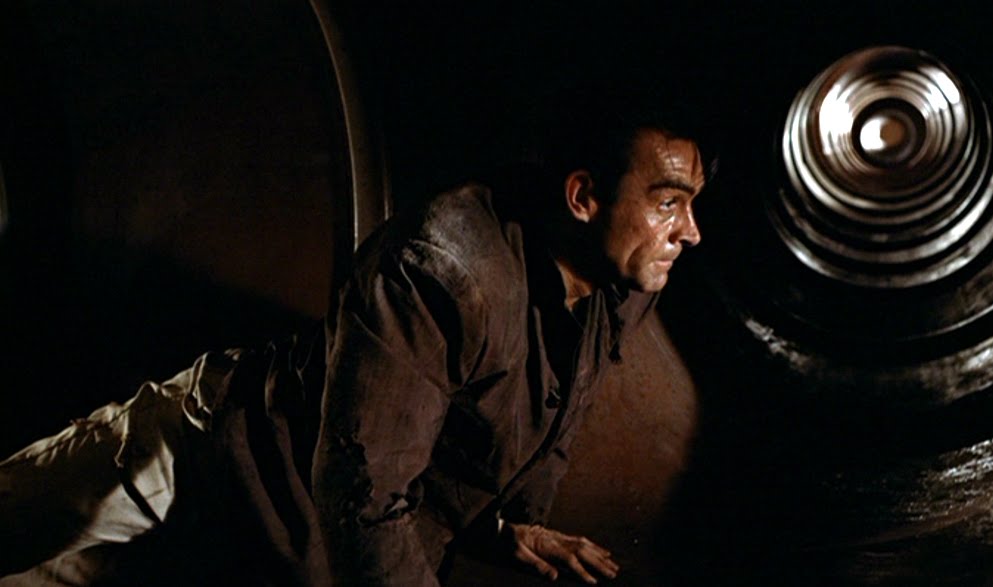
The following essay on Die Hard, Kafka, Deleuze, The Towering Inferno, Inception, James Bond, Heating, Ventilation, and Air Conditioning originally appeared in Volume 37: Is This Not a Pipe?
–
“So you’re telling me the new space is secure and the old street entry has been closed off?”
“Right. Everything looks good.” The security consultant nodded, satisfied at a job well done. It really was well done – the bank had as many theft deterrents as we could reasonably include. Like he repeatedly told me, you can’t design a bank that’s impossible to rob; you can only design a bank that’s harder to rob than the one across the street. With those wise words in mind, there was one thing that kept bugging me.
“What about that duct up there?” I asked.
“What about it?”
“Couldn’t someone get through there? I think it’s about 18-inches across.”
“You mean like Die Hard?” He looked skeptical.
“Exactly! Exactly like Die Hard.”
“Well…” the contractors sized up my slight frame then looked back up toward the exposed return duct. “I couldn’t make it through there but someone like, ah…”
“Me?”
“Yeah. You might be able to get through there. You planning to rob the place? ”
“If I was, it’d be a lot harder with that vent blocked.”
“Alright, I guess we can put some bars up there, McClane.”
During my former life as a designer, I actually had that conversation. Several times, in fact. And every time, Die Hard came up. Die Hard (1988) is a popcultural shorthand; it’s a simple, well-known reference that can be used to communicate complicated ideas – even between architects who love to overcomplicate things. When the security contractor asked me, “you mean like Die Hard?” what he was really saying was, “you mean someone with the proper motivation could crawl through the mechanical system of this building, which was not designed for the human body but rather for efficient air handling, and enter this bank surreptitiously?”
That is exactly what I mean.
The hero of Die Hard is New York City police officer John McClane (Bruce Willis in a defining role), a fish out of water who finds himself in the plumbing when a gang of international thieves commandeer an entire Los Angeles skyscraper, Nakatomi Plaza (played with a quiet dignity by Fox Plaza, designed by Johnson, Fain & Pereira Associates, 1987). Armed with little more than a zippo lighter and a chip on his shoulder the size of Madison Square Garden, McClane combats the invaders with architectural guerrilla tactics, evading detection by moving through ventilation ducts, elevator shafts, and seemingly every other conceivable space except those programmed by an architect. In the lesser, but still wildly entertaining sequels Die Harder, Die Hard With a Vengeance, Live Free or Die Hard, and A Good Day to Die Hard, John McClane finds himself, once again, climbing through infrastructural spaces, but the stakes get higher with each passing film as the devil-may-care “007 of Plainfield, New Jersey,” finds himself burrowing through our greatest and most complex spaces: an airport, New York City, the internet, Russia.
In a 2010 article, writer Geoff Manaugh branded the liminal territories that are tactically occupied in the Die Hard series as “Nakatomi Space, wherein buildings reveal near-infinite interiors, capable of being traversed through all manner of non-architectural means.”Nakatomi Space. What a terrific expression. It so succinctly describes such a complex idea – what Gilles Deleuze and Felix Guattari would call “Rhizomatic Space,” which, at its most basic, is a theoretical, nonhierarchical space constructed of elaborate connections and multiple points of access. But theory is so much easier to understand when buildings are blowing up so let’s just stick with Nakatomi Space.
Somewhere on the cultural spectrum between John McClane and Gilles Deleuze is Franz Kafka, whose stories are full of Nakatomi Space and other architectural viruses, none more explicit than “The Burrow” (1931). In this allegorical tale, a nameless, paranoid creature compulsively digs through the earth, creating an elaborate tunnel system to ward off possibly imaginary enemies. Among their enumerations on the concept of rhizome in A Thousand Plateaus, Deleuze and Guattari explicitly mention burrows, due to their “functions of shelter, supply, movement, evasion, and breakout.”[1] Those spatial functions inherent to the burrow are the same encountered by the fugitive. So while Manaugh equates Nakatomi Space with a type of militaristic movement, I see it more as a fugitive geography.
Though John McClane is undoubtedly the hero of the film, he is indeed a fugitive; a man singled out, hunted, and forced to flee through the liminal spaces of a Los Angeles high-rise. For McClane, as for the criminal fugitive, the built environment functions as both an accomplice and an obstacle, offering concealment one moment and obstructing escape the next. The same ducts that let McClane move undetected through the building might just bend or break at the wrong moment to reveal his location. His actions defy any architectural program or conventional circulation. The fugitive exists outside of design. His actions aren’t anticipated by the architect, planner, or engineer, so he must adapt and improvise. It seems appropriate then that McClane moves through undesigned space. The mechanical ducts he crawls through and elevator shafts he climbs are afterthoughts, consequences of architecture. Architects can go to great lengths to keep these systems concealed and the result is often an invisible labyrinth of articulation, a maze within a building, navigable only by currents of hot and cold air. And of course, the occasional New York City police officer.
In the 25 years since the release of Die Hard, watching a hero maneuvering through the innards of buildings has become something a cinematic trope. But Die Hard wasn’t the first film to feature such operative circulation, nor would it be the last.

The Towering Inferno (1974) features a similarly heroic protagonist, architect Doug Roberts (played by Paul Newman with almost Randian heroic aplomb), maneuvering through the Nakatomi Space of the world’s tallest building. Instead of evading criminals, he’s evading flames and explosions caused by faulty mechanical and electrical systems of the world’s tallest building and, as a result, disaster strikes during the opening soiree. While the titular tower takes center stage, its main “architectural” spaces are given short shrift because like Die Hard, this is a movie about guts – the guts of the building and of its architect. As the fire spreads up the 138th floor of the tower, Roberts crawls through the mechanical passages and climbs up the elevators shafts of the tallest building in the world, moving from floor to floor to single-handedly rescue women and children – and of course, to try to save his building. For a world famous architect, he knows an admirable amount about his building and its specifications, and his journey through its internal infrastructure sheds further light on its construction on the corner-cutting that caused the conflagration. The building reveals itself at the same time that it’s being reshaped by fire. Roberts adapts, he improvises. The elevators become death traps, but the elevator shafts become a primary mode of vertical circulation. Roberts sees his building fail in almost every way imaginable as a result of its faulty mechanical systems. But the tower would be impossible without these systems. And not just the Towering Inferno, but every tower. Without elevator and HVAC, most of our buildings wouldn’t be higher than five stories.
In his “Retroactive Manifesto for Manhattan” Delirious New York, Rem Koolhaas focuses on the elevator, describing it as “the great emancipator of all horizontal suffices above the ground floor” that allows tower occupants a “closer…communication with what remains of nature.”[2] But in our sealed glass towers, the commune with nature is not quite as pure as Koolhaas implies. At the great heights of the modern tower, windows are airtight while natural light and panoramic views are reserved for a few elite workers. The rest of the building’s occupants rely on the ducts, vents, pumps, and fans of the building’s mechanical system. If, as Koolhaas writes, “the elevator generates the first aesthetic based on the absence of articulation,” the mechanical space generated by building’s design could be considered an articulation based on the absence of aesthetic – the very essence of Nakatomi Space.
There are many other classic cinematic depictions of mechanical space. Almost the entire heist genre involves infiltration though at least one duct, shaft, or forgotten tunnel. The Mission Impossible (1996) films reinvented Nakatomi Space for a new generation, presenting new ways to move through a building’s services and security. The Oceans 11 (2001) remake similarly upped the ante by breaking into one of the most secure vaults in Vegas. In The Bank Job (2008) and The Day They Robbed the Bank of England (1960), robbers exploit or forgotten infrastructure of the city. In all these films, the exploitation of Nakatomi space reveals one of the greatest weaknesses of architecture: the optimistic naiveté of the architect – that is to say, the belief that a building will be used as it was designed to be used, and that it can’t be used for more nefarious –or sometimes heroic– purposes. Perhaps we could even consider these transgressions of conventional boundaries an act of architectural criticism.
However, the movement through these mechanical spaces is not truly a transgression of boundaries, but a subversion of existing conditions that emerged as a consequence of the architect’s design. American psychologist James Gibson coined the term “affordance” to explain the limited potential uses of a specific environment as determined by the objective qualities of that environment. Most affordances are obvious but others are latent, and potentially subversive. The exploitation of mechanical space as illicit circulation is only one example of architectural latency – and a particularly cinematic one at that.
There are two architectural fictions –one recent and one classic— in which the mechanical space is designed, where it’s use isn’t a latent affordance, but an intentional one. What’s more, it serves a critical part in the plot.
One of the protagonists of Inception, a heist movie with existential trappings, is a young architect who designs dreams and, through the magic of sci-fi , literally builds memory palaces –manifestations of the ancient Roman mnemonic device—in other people’s minds. During the film’s climax, the aptly named Ariadne creates a nearly impregnable, Brutalist ice fortress whose labyrinths can only be navigated by her team of highly trained dream-thieves. But as the plan inevitably goes awry and the team is attacked by mental constructs created in the mind of their intended target, it’s revealed that a contingency was put in place to cut through the elaborate architectural maze with a secret network of large ventilation ducts that ostensibly serve no purpose other than surreptitious entry. Once again, mechanical space becomes the primary mode of circulation to undermine architecture. Like the burrow in Kafka’s story, this space was designed by a protagonist facing enemies that were imagined into existence. The thoughts of Kafka’s sad burrower could easily could have come from one of Inception’s architects or paradox designers: “I certainly have the advantage of being in my own house and knowing all the passages and how they run. A robber may very easily become my victim….[But] I am not as strong as many others, and my enemies are countless; it could well happen that in flying from one enemy I might run into the jaws of another.”

In Ian Fleming’s novel Dr. No, James Bond quite literally runs from one enemy into the jaws of another when he is taken prisoner on a small island and thrown into a smaller gray cell whose “walls were entirely naked except for a ventilation grille of thick wire in one corner just below the ceiling.” Bond, being the super spy he is, sees the vent as an opportunity for escape. Unfortunately, the diabolical Dr. No planned for this. In fact, he wanted Bond to escape through the ducts, as he had transformed his mechanical system into an elaborate obstacle course designed to torture and kill the spy. Armed with little more than a lighter and a chip on his shoulder the size of Wembley Stadium, 007 attempts his escape through the ducts:
“Bond heaved up and through the opening and lay on his stomach looking along the shaft. The shaft was about four inches wider than Bond’s shoulders. It was circular and of polished metal. Bond reached for his lighter, blessing the inspiration that had made him take it, and flicked it on. Yes, zinc sheeting that looked new. The shaft stretched straight ahead, featureless except for the ridges where the sections of pipe joined. Bond put the lighter back in his pocket and snaked forward. It was easy going. Cool air from the ventilating system blew strongly in Bond’s face. The air held no smell of the sea – it was the canned stuff that comes from an air-conditioning plant. Doctor No must have adapted one of the shafts to his purpose. What hazards had he built into it to test out his victims? They would be ingenious and painful – designed to reduce the resistance of the victim. At the winning post, so to speak, there would be the coup de grâce – if the victim ever got that far. It would be something conclusive, something from which there would be no escape, for there would be no prizes in this race except oblivion – an oblivion, thought Bond, he might be glad to win.”
In evil lairs, even the HVAC is evil. As Bond crawled, squeezed, and climbed through the elaborate system of tunnels and shafts, he was exposed to electrified grills, scalding vents, and two dozen tarantulas before being dumped out into the sea to do battle with a giant squid. What Dr. No realized is that every aspect of a building –or a lair– can be designed.
That is what I wanted in my bank. But instead I get, “I guess we could put some bars in there.”
I imagine Dr. No’s conversation with his security consultant went a bit differently than mine:
“So you’re telling me these cells are completely secure?”
“Right. Everything looks good.” The security consultant nodded, satisfied at a job well done. And it was well done. The cell was nearly air tight, and inescapable save for a single small air duct sized to the Doctor’s precise specifications.
“As you know, I am interested in testing the limits of courage and of the human body to endure. However, it must of course be impossible for him to survive. It is impossible for him to escape alive, yes?”
“Well, you can’t design a lair that’s impossible to escape, you can only design a lair tha-“
“Guards!”
“Wait…no! I can fix this!” the consultant shouted as two oversized guards began dragging him away. “Rats! I’ll add rats!” His words fell on deaf ears. Dr. No was already barking orders to have the other consultant brought in. A few minutes later a dirty, rumbled young man wearing a dirty, rumbled suit was dragged out of a nearby cell. As he approached, the villainous doctor sized him up.
“And how do you feel about rats?”
“Too cliché. I’m thinking we should make the ducts scalding hot and fill them with tarantulas.” The doctor looked pleased.
“Is that it?”
“No, no!…and, ah…a giant squid?”
“Yes! Haha! A mechanical duct that empties into a lake containing a giant squid is exactly what we need! You’ll do just fine my boy, just fine indeed…”